List of colonial governors of New York facts for kids
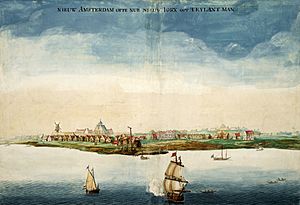
The territory which would later become the state of New York was settled by European colonists as part of the New Netherland colony (parts of present-day New York, New Jersey, Connecticut and Delaware) under the command of the Dutch West India Company in the Seventeenth Century. These colonists were largely of Dutch, Flemish, Walloon, and German stock, but the colony soon became a "melting pot." In 1664, at the onset of the Second Anglo-Dutch War, English forces under Richard Nicolls ousted the Dutch from control of New Netherland, and the territory became part of several different English colonies. Despite one brief year when the Dutch retook the colony (1673–1674), New York would remain an English and later British possession until the American colonies declared independence in 1776.
With the unification of the two proprietary colonies of East Jersey and West Jersey in 1702, the provinces of New York and the neighboring colony New Jersey shared a royal governor. This arrangement began with the appointment of Queen Anne's cousin, Edward Hyde, Lord Cornbury as Royal Governor of New York and New Jersey in 1702, and ended when New Jersey was granted its own royal governor in 1738.
Contents
Dutch Era of New Netherland (1624–1664; 1673–1674)
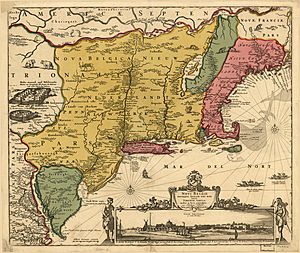
New Netherland (Dutch: Nieuw-Nederland) was the 17th-century colonial province of the Republic of the Seven United Netherlands and the Dutch West India Company. It claimed territories along the eastern coast of North America from the Delmarva Peninsula to southwestern Cape Cod. Settled areas of New Netherland are now constitute the states of New York, New Jersey, Delaware, and Connecticut, and parts of Pennsylvania and Rhode Island. The provincial capital New Amsterdam was located at the southern tip of the island of Manhattan at Upper New York Bay.
New Netherland was conceived as a private business venture to exploit the North American fur trade. By the 1650s, the colony experienced dramatic growth and became a major port for trade in the North Atlantic. The leader of the Dutch colony was known by the title Director or Director-General. On August 27, 1664, four English frigates commanded by Richard Nicolls sailed into New Amsterdam's harbor and demanded the surrender of New Netherland. This event sparked the Second Anglo-Dutch War, which led to the transfer of the territory to England per the Treaty of Breda.
| # | Portrait | Director (or Director-General) |
Took office | Left office | Notes |
|---|---|---|---|---|---|
| 1 | Cornelius Jacobsen May (fl. 1600s) |
1624 | 1625 |
|
|
| 2 | Willem Verhulst (or van der Hulst) (fl. 1600s) |
1625 | 1626 |
|
|
| 3 |  |
Peter Minuit (1580–1638) |
1626 | 1631 |
|
| 4 | Sebastiaen Jansen Krol (1595–1674) |
1632 | 1633 |
|
|
| 5 |  |
Wouter van Twiller (1606–1654) |
1633 | 1638 |
|
| 6 |  |
Willem Kieft (1597–1647) |
1638 | 1647 |
|
| 7 | 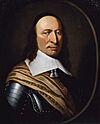 |
Peter Stuyvesant (c. 1612–1672) (Director General) |
1647 | 1664 |
|
Restoration of the colony, 1673–1674
In 1673, during the Third Anglo-Dutch War, the Dutch were able to recapture New Amsterdam (renamed "New York" by the British) under Admiral Cornelis Evertsen the Youngest and Captain Anthony Colve. Evertsen renamed the city "New Orange." Evertsen returned to the Netherlands in July 1674, and was accused of disobeying his orders. Evertsen had been instructed not to retake New Amsterdam but instead to conquer the British colonies of Saint Helena and Cayenne (now French Guiana). In 1674, the Dutch were compelled to relinquish New Amsterdam to the British under the terms of the Second Treaty of Westminster.
| Portrait | Governor | Took office | Left office | Notes |
|---|---|---|---|---|
| Anthony Colve (fl. 1600s) |
1673 | 1674 |
|
Under British control (1664–1673; 1674–1783)
Apart from a short period between May 1688 and April 1689, during which New York was part of the Dominion of New England, the territory was known in this period as the Province of New York.
| # | Portrait | Governor | Took office | Left office | Notes |
|---|---|---|---|---|---|
| 1 | Richard Nicolls (1624–1672) |
1664 | 1668 | as military governor | |
| 2 | 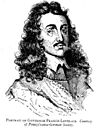 |
Francis Lovelace (1621–1675) |
1668 | 1673 | |
| 3 | Anthony Colve (Dutch Governor) | 1673 | 1674 | Dutch former naval captain who became Governor under a restored Dutch rule | |
| 4 | 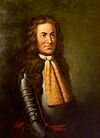 |
Edmund Andros (1637–1714) |
1674 | 1683 | |
| 5 | Anthony Brockholls (c. 1656) |
1681 | 1683 | Commander-in-Chief of British Forces and acting governor | |
| 6 | 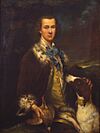 |
Thomas Dongan, 2nd Earl of Limerick (1634–1715) |
1683 | 1688 | |
| 7 |  |
Francis Nicholson (1655–1728) |
1688 | 1691 | as lieutenant governor of the Dominion of New England serving under Edmund Andros; de facto rule only until June 1689 |
| 8 |  |
Jacob Leisler (c. 1640–1691) |
1688 | 1691 | Militia officer in rebellion |
| 9 | Henry Sloughter (d. 1691) |
1691 | 1691 | ||
| 10 | Richard Ingoldesby (d. 1719) |
1691 | 1692 | Military officer as acting governor | |
| 11 | Benjamin Fletcher (1640–1703) |
1692 | 1697 | ||
| 12 | 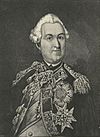 |
Richard Coote, 1st Earl of Bellomont (c. 1636–1700/1) |
1698 | 1700/1 | |
| 13 | John Nanfan (1634–1716) |
1701 | 1702 | as acting governor | |
| 14 | Edward Hyde, 3rd Earl of Clarendon (1661–1723) |
1702 | 1708 | ||
| 15 | John Lovelace, 4th Baron Lovelace (1672–1709) |
1708 | 1709 | ||
| 16 | 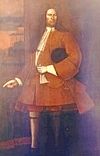 |
Pieter Schuyler (1657–1724) |
1709 | 1709 | as acting governor |
| 17 | Richard Ingoldesby (d. 1719) |
1709 | 1710 | as acting governor | |
| 18 |  |
Gerardus Beekman (1653–1723) |
1710 | 1710 | as acting governor |
| 19 | 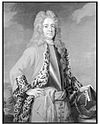 |
Robert Hunter (1664–1734) |
1710 | 1719 | |
| 20 |  |
Pieter Schuyler (1657–1724) |
1719 | 1720 | as acting governor |
| 21 |  |
William Burnet (1687/8–1729) |
1720 | 1728 | |
| 22 | John Montgomerie (d. 1731) |
1728 | 1731 | ||
| 23 |  |
Rip Van Dam (c. 1660–1749) |
1731 | 1732 | as acting governor |
| 24 | 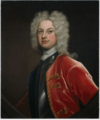 |
William Cosby (1690–1736) |
1732 | 1736 | |
| 25 | 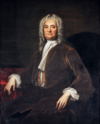 |
George Clarke (1676–1760) |
1736 | 1743 | as acting governor |
| 26 | George Clinton (c. 1686–1761) |
1743 | 1753 | ||
| 27 |  |
Sir Danvers Osborn, 3rd Baronet (1715–1753) |
1753 | 1753 | |
| 28 | James De Lancey (1703–1760) |
1753 | 1755 | as acting governor | |
| 29 | 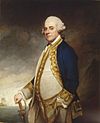 |
Charles Hardy (c. 1714–1780) |
1755 | 1758 | |
| 30 | James De Lancey (1703–1760) |
1758 | 1760 | as acting governor | |
| 31 | 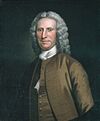 |
Cadwallader Colden (1688–1776) |
1760 | 1762 | as acting governor |
| 32 | 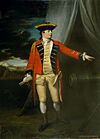 |
Robert Monckton (1726–1782) |
1762 | 1763 | |
| 33 |  |
Cadwallader Colden (1688–1776) |
1763 | 1765 | as acting governor |
| 34 | Sir Henry Moore, 1st Baronet (1713–1769) |
1765 | 1769 | ||
| 35 |  |
Cadwallader Colden (1688–1776) |
1769 | 1770 | as acting governor |
| 36 | 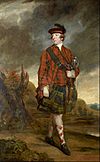 |
John Murray, 4th Earl of Dunmore (1730–1809) |
1770 | 1771 | |
| 37 | 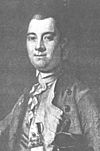 |
William Tryon (1729–1788) |
1771 | 1774 | |
| 38 |  |
Cadwallader Colden (1688–1776) |
1774 | 1775 | as acting governor |
| 39 |  |
William Tryon (1729–1788) |
1775 | 1780 | |
| 40 | James Robertson (1717–1788) |
1780 | 1783 | as military governor | |
| 41 | Andrew Elliot (1728–1797) |
1783 | 1783 | as military governor |
See also
- For a list of governors of New York state after independence (1777–present), see: List of governors of New York.
- Director-General of New Netherland, for a list of the Governors of New Netherland from 1624 to 1664.
- List of colonial governors of New Jersey

